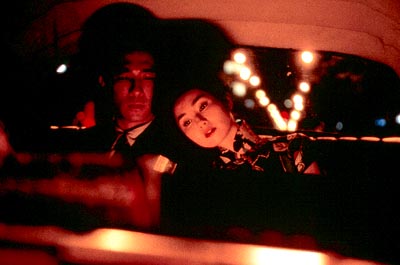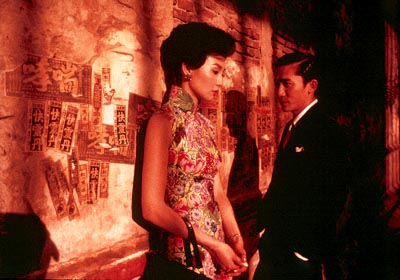In the Mood for Love


There is so much coolness in In the Mood for Love that it literally drips off the screen. Cinephiles adore the stylistic trappings of Hong Kong director Wong Kar-wai because of his eye for the visual. Sadly, what makes In the Mood for Love so amazing to look at will probably turn away the legions of people needed to elevate Wong's status beyond that of art house darling. Wong's films are always a feast for the eyes, and this one is no different. In the Mood for Love won two well-deserved awards at Cannes in 2000; Best Actor and the Grand Prix de la Technique (an award for production design, cinematography, and editing).
The story centers on two people in 1962 Hong Kong. Mr. Chow (Tony Leung, The Longest Nite, Flowers of Shanghai) and Mrs. Chan (Maggie Cheung, Irma Vep, Ashes of Time) live next to each other in a crowded apartment building. They are acquaintances, passing each other in the hall and on the street, and casually engaging in small talk with each other every once in a while. Both are married, but their spouses are always away. Eventually, they both realize that their spouses are having an affair with each other, and the two seek solace together. However, Chow and Chan do not want to stoop to the level of their spouses. They want to try to understand why it happened. These are two profoundly sad and lonely people, who hide behind masks of politeness. Yet there is a tension between them. Every time they meet, they come across a line they do not want to cross.
The extraordinary element of In the Mood for Love is the look of the film. Amidst a dumpy neighborhood, Chow and Chan prominently stand out. Leung gels his hair meticulously so that not one strand sticks up. Except for one scene, he is never without his tie. Cheung parades across the screen in luxurious cheongsams, tight, high-necked dresses. Cheung and Chow look like they stepped out of a catalogue. At times, Wong (Chungking Express, Happy Together) slows the camera and lets it move slowly across Leung and Cheung as Michael Galasso and Umebayashi Shigeru's seductive music plays. At other times, Nat King Cole croons in Spanish in the background. One excellent scene has Leung sitting at a table. Wong focuses on the smoke from his cigarette, rising slowly and dissipating above his head.
In the Mood for Love is less about the story and more about tone. The lack of a prominent story is what will make some people nervous. Instead, they should focus on the technical aspects of the movie. Wong's camera is like a voyeur. He shoots scenes from outside windows and around corners. It's almost as if the audience is spying on the two people. Wong also chooses never show Mr. Chan or Mrs. Chow. All the audience sees is the occasional back of the head or hears a stray voice. The focus is completely on Leung and Cheung, and the camera loves them.